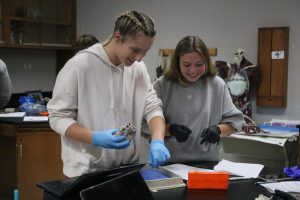Science department modifies its scoring system
February 8, 2017
As students sit in science class staring at a test in front of them, they try to recollect everything they studied for hours the night before. Remembering tests count toward 75 percent of the grade for the course, they know an A on the test is needed to maintain the grade they currently have for the marking period.
“During the summer, some of the teachers attended professional development on ‘15 Fixes for Broken Grades,’” science department chair Lisa Stewart said. “We all had to look at what we could do for grades to be fixed and make sure everybody is getting the grade they should receive and everyone was more on an equal playing field. One of the major fixes was to have the grade reflect what students know when they leave the class, not what they were able to do homework wise, get from a textbook and share with friends.”
The science department changed the way of grading students by adjusting the percentage of formative and summative assessments.
“The grade should reflect what you actually know,” Stewart said. “The 75 percent of your grade that is summative is based on your knowledge of the material and that might be a test or lab practical. Twenty-five percent of the grade is formative; these are the assessments you can collaborate on and use the Internet.”
With 75 percent of a student’s grade based on tests, students now have to focus more on studying for tests and working harder on the labs.
“I have had students who have not done well because they aren’t test takers and those are the people I feel bad for,” science teacher Lynnette Behr said. “They are stuck with this grade that is largely weighted on something that is not their strength. The hope is with that formative grade of 75 percent that still gives them the benefit of doing their work.”
Some students have seen their grades drop because of the heavy weight of test on the final grade.
“My grades definitely have been different since last year,” sophomore Gracie Niec said. “My test grades are lower because I don’t try to retake tests; I’m afraid that I could get a worse grade.”
Students are given the opportunity to retake tests if they are unhappy with their original score, which is something they could not do prior to this year.
“With this grading scale, students have one chance to retake a test,” Stewart said. “So if they do poorly on a test, they have another chance. The point is if students didn’t know the information the first time, they can go back and look over the information they didn’t know the first time and then restudy those facts so they can come back and retake the test. But with this system, the rule is that you have to take the second grade no matter what.”
In fear of getting a worse grade and having to keep it, some students will not retake a test with the new policy in place.
“I’m really not a fan of the change,” Niec said. “I think it’s worse because of how uneven the balance is between the summative and formative assessments. The change has stopped me from retaking a test multiple times because I was worried I’d get a worse grade than I already had. It used to be that if you retook a test, you would either get the retake grade, the higher grade or your grade would be the mean of the two grades. But now your grade is always the retake grade, so if you completely bombed the retake for some reason, you’d be stuck with that grade instead of the higher grade.”
Following midterms, science teachers will get together and compare scores from this year from previous ones.
“We will be looking at the semester average grades from this year and a compare them to last year and the years before that,” Stewart said. “So if we see that the average has improved then we know it has worked.”








